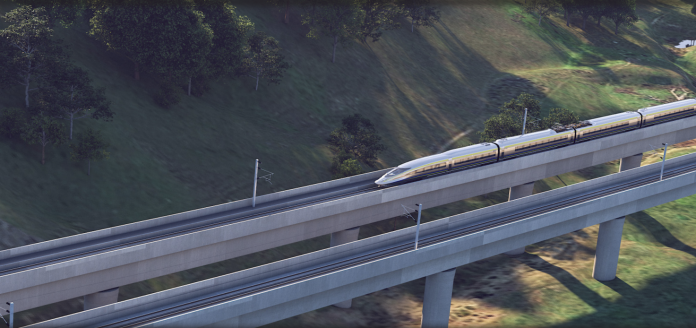State High-Speed Rail officials this week adopted a track alignment for the San Jose to Merced section that goes through downtown Morgan Hill and includes a station in Gilroy.
On April 28, the California High-Speed Rail Authority board of directors certified the Final Environmental Impact Report and Environmental Impact Statement, and unanimously approved “Alternative 4” for the 90-mile section alignment.
The board’s vote completes the environmental clearance for nearly 400 miles of the High-Speed Rail’s 500-mile “Phase 1” alignment from San Francisco to Los Angeles and Anaheim, says a press release from the HSRA. The board’s April 28 actions also represent its first certification of a project section’s environmental studies in Northern California.
“Today’s approval represents another major milestone and brings us one step closer to delivering high-speed rail between the Silicon Valley and the Central Valley,” HSRA CEO Brian Kelly said. “The authority is poised to make the vision of high-speed rail in the Bay Area a reality. We look forward to continued collaboration with our federal, state and local partners to advance the project in Northern California.”
The HSRA began the EIR process for the San Jose to Merced section more than two years ago. The in-depth study considered the impacts of four section alignment alternatives, as well as a no-project alternative.
Alternative 4 will take the bullet train tracks through the downtown areas of Morgan Hill and Gilroy, along the existing Union Pacific Railroad tracks.
HSRA staff added that Alternative 4 will modernize and electrify the existing rail corridor between San Jose and Gilroy, allowing for both HSR and Caltrain service.
“Next to San Jose, Gilroy will be the next most significant transit hub on this stretch,” said Gilroy Mayor Marie Blankley. “Gilroy Transit Center is very much ready for this to happen.”
Morgan Hill city council members and city staff had expressed a number of concerns with Alternative 4 during the public comment period, including with the lack of HSR track grade separations at East Dunne, Tennant and Tilton. The council in June 2020 had sent feedback to the HSRA urging them to consider adding grade separations at those intersections, allowing vehicle, pedestrian and bicycle traffic to cross under the HSR tracks without the bullet train and road traffic interfering with each other.
“(Grade) separations at these crossings are the appropriate and necessary solutions to several environmental impacts specifically, but not limited to safety response times, circulation, and noise as disclosed in the EIR/EIS for which vague and unconvincing mitigation measures have been offered,” says the city’s June 2020 letter.
The HSRA board did not implement such considerations when adopting Alternative 4 on April 28.
Morgan Hill officials had preferred an alignment that took the HSRA system within the U.S. 101 right of way on the east side of town.
Mayor Rich Constantine said that when it comes to vehicle traffic, two of Morgan Hill’s intersections that cross existing railroad tracks—Dunne and Tennant avenues—are among the five busiest along the entire Caltrain corridor from San Francisco to Gilroy. That means the potential traffic hold ups and emergency response delays from High-Speed Rail crossings could be “significant” when the system is fully built out, Constantine said.
“If the (High-Speed Rail crossing) gates are down for 30 seconds for each train, that’s a significant amount of time” to delay vehicle traffic, said Constantine, who is a retired firefighter. “If it’s an emergency—I’ve been in that situation where we respond to a call and have to stop because of a train.”
Morgan Hill Assistant City Manager Edith Ramirez added that city staff has continued to provide comments on the High-Speed Rail EIR, and continued to advocate for grade separations along the route as it crosses busy intersections in the city limits.
The San Jose to Merced section goes from Scott Boulevard in Santa Clara to Carlucci Road in Merced County. The segment will travel through or near the communities of Santa Clara, San Jose, Morgan Hill, Gilroy and Los Banos. The project includes high-speed rail stations at San Jose Diridon and in Gilroy, as well as a maintenance facility south or southeast of Gilroy.
The section will connect existing HSR construction in the Central Valley with Diridon Station. The HSR will take travelers from Fresno to San Jose in one hour, according to HSRA staff.
San Jose Mayor Sam Liccardo said, “I am grateful, as are all of us in the City of San Jose, for the extraordinary work that’s now culminated in this environmental document reflecting thousands of hours of stakeholder outreach and an enormous amount of environmental analysis. Completion of this critically important high-speed rail project helps the state expand economic opportunity and affordable housing, two critical goals for all of us.”
The board’s certification of the EIR and EIS marks a key milestone in the statewide project, moving the project section closer to “shovel ready,” says the press release. Construction of the project section is not yet fully funded.
East of Gilroy, the alignment includes more than 15 miles of tunnels through the Pacheco Pass in the Diablo Range. The Board will consider certification for the final environmental document for the San Francisco to San Jose project section this summer.
California High-Speed Rail is currently under construction along 119 miles in the Central Valley at 35 active job sites, says the press releases. To date, more than 7,500 construction jobs have been created since the start of construction.
When voters approved a $9.95 billion bond measure in 2008 to kick start the High-Speed Rail project, the total projected cost was about $30 billion and it was slated to be complete by 2030. Since then, the price tag has ballooned higher than $100 billion, and officials have yet to identify where most of the funding will come from to complete the first phase between San Francisco and Anaheim.








